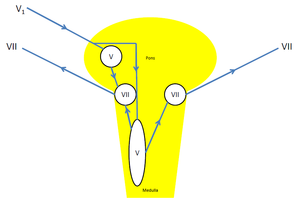Blink Reflex: Difference between revisions
No edit summary |
No edit summary |
||
| Line 4: | Line 4: | ||
== Introduction == | == Introduction == | ||
It is an electrodiagnostic test that evokes the corneal reflex.<ref name=":0">Hartmann J.E. (2013) Blink Reflex. In: Kountakis S.E. (eds) Encyclopedia of Otolaryngology, Head and Neck Surgery. Springer, Berlin, Heidelberg. <nowiki>https://doi.org/10.1007/978-3-642-23499-6_904</nowiki></ref> It evaluates the integrity of the trigeminal and facial nerve.<ref name=":0" /><ref name=":1" /> | It is an electrodiagnostic test that evokes the corneal reflex.<ref name=":0">Hartmann J.E. (2013) Blink Reflex. In: Kountakis S.E. (eds) Encyclopedia of Otolaryngology, Head and Neck Surgery. Springer, Berlin, Heidelberg. <nowiki>https://doi.org/10.1007/978-3-642-23499-6_904</nowiki></ref> It evaluates the integrity of the trigeminal and [[Facial Nerve|facial nerve]].<ref name=":0" /><ref name=":1" /> | ||
== Neuroanatomy == | == Neuroanatomy == | ||
The supraorbital branch of the ophthalmic division of the trigeminal nerve constitutes the afferent arm, while the motor fibers of the facial nerve form the efferent arm of this reflex.<ref name=":0" /><ref name=":1">Kimura J (2001) The blink reflex. In: Electrodiagnosis in diseases of nerve and muscle: principles and practice. Oxford University Press, New York</ref> The diagram below depicts the pathway of the blink reflex. | The supraorbital branch of the ophthalmic division of the trigeminal nerve constitutes the afferent arm, while the motor fibers of the [[Facial Nerve|facial nerve]] form the efferent arm of this reflex.<ref name=":0" /><ref name=":1">Kimura J (2001) The blink reflex. In: Electrodiagnosis in diseases of nerve and muscle: principles and practice. Oxford University Press, New York</ref> The diagram below depicts the pathway of the blink reflex. | ||
[[File:BLINK REFLEX - ARNOLD F DSOUZA.png|thumb|Pathway of the Blink Reflex|none]] | [[File:BLINK REFLEX - ARNOLD F DSOUZA.png|thumb|Pathway of the Blink Reflex|none]] | ||
| Line 18: | Line 18: | ||
== Indications == | == Indications == | ||
It is indicated in facial palsies (especially Bell's palsy), acoustic neuromas, brain stem lesions such as stroke or tumors, multiple sclerosis, and polyneuropathies like Guillain-Barre syndrome.<ref name=":0" /> | It is indicated in [[Facial Palsy|facial palsies]] (especially Bell's palsy), [[Acoustic Neuroma|acoustic neuromas]], [[Brainstem|brain stem]] lesions such as [[stroke]] or [[Brain Tumors|tumors]], multiple sclerosis, and polyneuropathies like Guillain-Barre syndrome.<ref name=":0" /> | ||
== Contraindications == | == Contraindications == | ||
| Line 24: | Line 24: | ||
== Advantages == | == Advantages == | ||
No effort is needed on the patient's end. Unlike traditional tests like the nerve conduction study, this test evaluates both the intracranial and extracranial sections of the trigeminal and facial nerve.<ref name=":0" /> | No effort is needed on the patient's end. Unlike traditional tests like the nerve conduction study, this test evaluates both the intracranial and extracranial sections of the trigeminal and [[Facial Nerve|facial nerve]].<ref name=":0" /> | ||
== Disadvantages == | == Disadvantages == | ||
Revision as of 07:28, 29 August 2020
Top Contributors - Arnold Fredrick D'Souza
Introduction[edit | edit source]
It is an electrodiagnostic test that evokes the corneal reflex.[1] It evaluates the integrity of the trigeminal and facial nerve.[1][2]
Neuroanatomy[edit | edit source]
The supraorbital branch of the ophthalmic division of the trigeminal nerve constitutes the afferent arm, while the motor fibers of the facial nerve form the efferent arm of this reflex.[1][2] The diagram below depicts the pathway of the blink reflex.
Technique[edit | edit source]
The subject is supine and asked to stay relaxed with their eyes open or gently closed. The active electrode is placed over the orbicularis oculus while the reference electrode is placed over the chin or nose. The ground electrode can be placed over the forehead or at the nape of the neck. Using a prong stimulator, each supraorbital nerve is stimulated and the response from the orbicularis oculus is recorded bilaterally. Habituation is prevented by allowing a rest period of a few seconds between successive stimuli.[1][2]
Interpretation[edit | edit source]
Normally, as with the corneal reflex, the ipsilateral electrical stimulation of the trigeminal nerve will produce an eye blink bilaterally.[2]
Indications[edit | edit source]
It is indicated in facial palsies (especially Bell's palsy), acoustic neuromas, brain stem lesions such as stroke or tumors, multiple sclerosis, and polyneuropathies like Guillain-Barre syndrome.[1]
Contraindications[edit | edit source]
There are no absolute contraindications, but an uncooperative patient or post-operative wounds or dressings can hamper the test procedure.[1]
Advantages[edit | edit source]
No effort is needed on the patient's end. Unlike traditional tests like the nerve conduction study, this test evaluates both the intracranial and extracranial sections of the trigeminal and facial nerve.[1]
Disadvantages[edit | edit source]
For better accuracy, the patient must be completely relaxed and extend full co-operation. The stimulation of the supraorbital nerve can be quite painful for some.[1]
References[edit | edit source]
- ↑ 1.0 1.1 1.2 1.3 1.4 1.5 1.6 1.7 Hartmann J.E. (2013) Blink Reflex. In: Kountakis S.E. (eds) Encyclopedia of Otolaryngology, Head and Neck Surgery. Springer, Berlin, Heidelberg. https://doi.org/10.1007/978-3-642-23499-6_904
- ↑ 2.0 2.1 2.2 2.3 Kimura J (2001) The blink reflex. In: Electrodiagnosis in diseases of nerve and muscle: principles and practice. Oxford University Press, New York
- ↑ NEUROWERK by SIGMA Medizin-Technik (2014) Reflexes - Blink Reflex. Available at: https://www.youtube.com/watch?v=_LTEdal_wWA (Accessed 29 August 2020)







